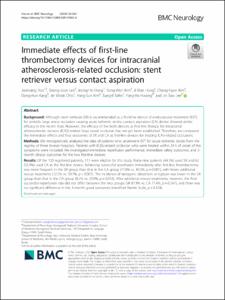Immediate effects of first-line thrombectomy devices for intracranial atherosclerosis-related occlusion: stent retriever versus contact aspiration
- Alternative Author(s)
- Yoo, Joon Sang; Hong, Jeong Ho; Kim, Chang Hyun; Sohn, Sung Il
- Journal Title
- BMC neurology
- ISSN
- 1471-2377
- Issued Date
- 2020
- Keyword
- Ischemic stroke; Reperfusion therapy; Stent retriever; Contact aspiration; Intracranial atherosclerosis; Endovascular treatment
- Abstract
- Background:
Although stent retriever (SR) is recommended as a frontline device of endovascular treatment (EVT) for embolic large artery occlusion causing acute ischemic stroke, contact aspiration (CA) device showed similar efficacy in the recent trials. However, the efficacy of the both devices as first-line therapy for intracranial atherosclerotic stenosis (ICAS)-related large vessel occlusion has not yet been established. Therefore, we compared the immediate effects and final outcomes of SR and CA as first-line devices for treating ICAS-related occlusions.
Methods:
We retrospectively analyzed the data of patients who underwent EVT for acute ischemic stroke from the registry of three Korean hospitals. Patients with ICAS-related occlusion who were treated within 24 h of onset of the symptoms were included. We investigated immediate reperfusion performance, immediate safety outcomes, and 3-month clinical outcomes for the two first-line devices.
Results:
Of the 720 registered patients, 111 were eligible for this study. Forty-nine patients (44.1%) used SR and 62 (55.9%) used CA as the first-line device. Achieving successful reperfusion immediately after first-line thrombectomy was more frequent in the SR group than that in the CA group (77.6% vs. 43.5%, p = 0.001), with fewer additional rescue treatments (12.2% vs. 59.7%, p < 0.001). The incidence of iatrogenic dissection or rupture was lower in the SR group than that in the CA group (8.2% vs. 29.0%, p = 0.012). After additional rescue treatments, however, the final successful reperfusion rate did not differ between the two groups (SR 87.8% vs. CA 77.4%, p = 0.247), and there was no significant difference in the 3-month good outcomes (modified Rankin Scale, p = 0.524).
Conclusions:
First-line SR thrombectomy showed higher immediate reperfusion and less vessel injury for ICAS-related occlusions than CA. However, there was no significant difference in the final reperfusion status or 3-month outcomes from additional rescue treatments.
- Department
- Dept. of Neurology (신경과학)
- Publisher
- School of Medicine (의과대학)
- Citation
- Joonsang Yoo et al. (2020). Immediate effects of first-line thrombectomy devices for intracranial atherosclerosis-related occlusion: stent retriever versus contact aspiration. BMC neurology, 20(1), 283. doi: 10.1186/s12883-020-01862-6
- Type
- Article
- ISSN
- 1471-2377
- Appears in Collections:
- 1. School of Medicine (의과대학) > Dept. of Neurology (신경과학)
- 파일 목록
-
-
Download
 oak-2020-0200.pdf
기타 데이터 / 779.59 kB / Adobe PDF
oak-2020-0200.pdf
기타 데이터 / 779.59 kB / Adobe PDF
-
Items in Repository are protected by copyright, with all rights reserved, unless otherwise indicated.